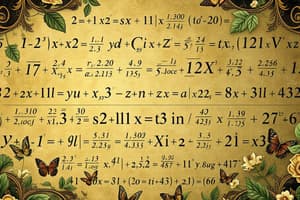Podcast
Questions and Answers
Which operation is a fundamental concept in algebra?
Which operation is a fundamental concept in algebra?
- Addition and subtraction (correct)
- Multiplication only
- Long division
- Calculating percentage
What is the purpose of using a variable in algebra?
What is the purpose of using a variable in algebra?
- To eliminate equations
- To express constants only
- To create a fixed value
- To represent an unknown quantity (correct)
Which of these is an example of a linear equation?
Which of these is an example of a linear equation?
- $3x - 4 = 12$ (correct)
- $y = x^3$
- $7 + 2y = 3y$
- $x^2 + 5 = 10$
When solving the equation $2x + 3 = 11$, what operation is typically performed first?
When solving the equation $2x + 3 = 11$, what operation is typically performed first?
What is the solution to the equation $x - 7 = 0$?
What is the solution to the equation $x - 7 = 0$?
Flashcards
Algebra
Algebra
A branch of mathematics that deals with symbols and the rules for manipulating them.
Mathematical symbols
Mathematical symbols
Representations like +, -, x, /, =, etc., used in algebra.
Variables in algebra
Variables in algebra
Letters (e.g., x, y, z) representing unknowns in equations.
Equations in algebra
Equations in algebra
Signup and view all the flashcards
Solving equations
Solving equations
Signup and view all the flashcards
Study Notes
Introduction to Algebra
- Algebra is a branch of mathematics that uses symbols to represent numbers and other mathematical objects.
- It deals with the relationships between quantities and the rules for manipulating those quantities.
- It extends arithmetic by introducing variables and equations.
- It provides a powerful tool to solve problems and model real-world situations.
Basic Concepts
- Variables: Symbols (usually letters like x, y, z) that represent unknown or unspecified numbers.
- Constants: Numbers with fixed values.
- Expressions: Combinations of variables and constants connected by mathematical operations (addition, subtraction, multiplication, division, etc.).
- Equations: Statements that equate two expressions. They usually include an equals sign (=). Solving an equation involves finding the value(s) of the variable(s) that make the equation true.
- Inequalities: Statements that compare two expressions using inequality symbols (<, >, ≤, ≥). Solving inequalities involves finding the range of values for the variable(s) that make the inequality true.
Fundamental Operations
- Addition: Combining quantities.
- Subtraction: Finding the difference between quantities.
- Multiplication: Repeated addition. Also represented by symbols like *, ⋅, or parentheses (e.g., 2x).
- Division: Finding how many times one quantity is contained within another. Often represented by a fraction bar (e.g., x/2).
Properties of Operations
- Commutative Property: Changing the order of addition or multiplication does not change the result (e.g., a + b = b + a; a × b = b × a).
- Associative Property: Grouping numbers in addition or multiplication does not change the result (e.g., (a + b) + c = a + (b + c); (a × b) × c = a × (b × c)).
- Distributive Property: Distributing a factor over terms in a sum (e.g., a × (b + c) = a × b + a × c).
- Identity Properties: Adding zero to a number does not change the number (a + 0 = a). Multiplying a number by one does not change the number (a × 1 = a).
- Inverse Properties: Addition and subtraction are inverse operations. Multiplication and division are inverse operations. Finding the inverse operation reverses the action of the original operation.
Solving Equations
- Isolating the Variable: The goal is to manipulate both sides of the equation to get the variable by itself on one side.
- Using Inverse Operations: Applying inverse operations to both sides of the equation.
- Simplifying Expressions: Often necessary before isolating the variable.
- Checking Solutions: Substituting the solution back into the original equation to verify the answer.
Linear Equations
- Equations where the highest power of the variable is 1.
- Often represented in the form Ax + B = C, where A, B, and C are constants.
- Common application of solving linear equations involves geometrical problems or real-world problems.
Exponents and Radicals
- Exponents: Used to represent repeated multiplication.
- Radicals: Used to represent roots of numbers.
- Rules for evaluating expressions involving exponents and radicals are important for simplification and calculations.
Polynomials
- Expressions built from variables, constants and exponents.
- Operations between polynomials follow the rules for working with terms, coefficients and exponents.
Factoring
- Breaking down a polynomial into simpler expressions.
- Helps to solve equations and simplify expressions.
Word Problems
- Applications of algebraic concepts to real-world situations.
- Translating word problems into algebraic equations is crucial.
- Solving these equations yields solutions for the problem.
Studying That Suits You
Use AI to generate personalized quizzes and flashcards to suit your learning preferences.




